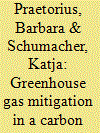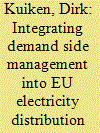|
|
|
Sort Order |
|
|
|
Items / Page
|
|
|
|
|
|
|
| Srl | Item |
| 1 |
ID:
092733


|
|
|
|
|
| Publication |
2009.
|
| Summary/Abstract |
Carbon capture and storage (CCS) promises to allow for low-emissions fossil-fuel-based power generation. The technology is under development; a number of technological, economic, environmental and safety issues remain to be solved. CCS may prolong the prevailing coal-to-electricity regime and countervail efforts in other mitigation categories. Given the need to continue using fossil-fuels for some time, however, it may also serve as a bridging technology towards a renewable energy future. In this paper, we analyze the structural characteristics of the CCS innovation system and perform an energy-environment-economic analysis of the potential contribution of CCS, using a general equilibrium model for Germany. We show that a given climate target can be achieved at lower marginal costs when the option of CCS is included into the mix of mitigation options. We conclude that, given an appropriate legal and policy framework, CCS, energy efficiency and some other mitigation efforts are complementary measures and should form part of a broad mix of measures required for a successful CO2 mitigation strategy.
|
|
|
|
|
|
|
|
|
|
|
|
|
|
|
|
| 2 |
ID:
166524


|
|
|
|
|
| Summary/Abstract |
Wind and solar power are predicted to dominate CO2 emission reductions in future electricity systems. Unlike spatially compact fossil fuels, harnessing renewable energy flows increases the land area impact of electricity production. This study quantifies the trade-offs between land area impacts, technology alternatives of decarbonisation pathways, and costs associated with reducing carbon emissions from electricity generation by ~ 90%.
|
|
|
|
|
|
|
|
|
|
|
|
|
|
|
|
| 3 |
ID:
166563


|
|
|
|
|
| Summary/Abstract |
The EU goals for renewable electricity cause significant changes of electrical loads in distribution systems, in which most renewable electricity sources are integrated. This poses a challenge for distribution system operators (DSOs) as their networks are not designed for such load changes. DSOs could use networks more efficiently with demand side management (DSM), where consumers of electricity alter their consumption patterns, shifting (production/consumption) loads in the distribution system. In such a setting, consumers would trade DSM services with the DSOs. However, currently, DSOs follow the ‘copper plate approach’, which assumes the system should have sufficient capacity to ensure that the desired volumes of electricity can be transported. This seeks to guarantee regulated third party access (rTPA) for all system users. Next to rTPA, based on regulated tasks, DSOs should ensure secure, reliable and efficient systems. In doing so, the DSOs are bound by unbundling requirements, which do not allow them to be involved in any activities other than those related to distribution. Therefore, especially production and supply are not allowed. Still, it seems debatable whether EU law allows DSOs to apply DSM, as it has an impact on both the access conditions to the electricity system, and the production, supply and trade of electricity. This article further analyses how DSM relates to the legal framework of DSOs, which obstacles are present, and how DSM could be traded between DSOs and system users.
|
|
|
|
|
|
|
|
|
|
|
|
|
|
|
|
| 4 |
ID:
132655


|
|
|
|
|
| Publication |
2014.
|
| Summary/Abstract |
Renewable energy promotion and its cost are at the heart of the energy policy debate in many countries. The question from an economic perspective is how expensive the promotion of renewable sources through price-based incentive schemes is. This paper addresses this issue empirically. We analyze the Spanish electricity market during the period 2008-2012, where renewable energy production rose by 57%. To determine how expensive it was, we first measure the savings due to the spot price reduction driven by the merit order effect and, second, we compute the amount paid as incentives to green energy by the electricity system; the difference between the two is the net cost of green energy to the electricity markets. We present aggregate results for renewable sources as a whole, as well as individual results for each technology. We show that at the initial stages, when renewable capacity was low, green energy promotion paid for itself (2008-2009); however, from 2010 on, when renewable production reached a relatively high level, it started to impose a positive net cost on the system. Finally, we found substantial differences among technologies: wind energy implied the lowest net cost, while solar photovoltaic was the most expensive.
|
|
|
|
|
|
|
|
|
|
|
|
|
|
|
|
|
|
|
|
|